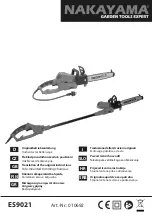
English
7
NOTE:
This could also mean a problem with a charger.
If the charger indicates a problem, take the charger and battery pack to be tested at an
authorized service center.
HOT/COLD PACK DELAY
When the charger detects a battery pack that is too hot or too cold, it automatically starts a
Hot/Cold Pack Delay, suspending charging until the battery pack has reached an appropriate
temperature. The charger then automatically switches to the pack charging mode. This
feature ensures maximum battery pack life.
A cold battery pack will charge at a slower rate than a warm battery pack. The battery pack
will charge at that slower rate throughout the entire charging cycle and will not return to
maximum charge rate even if the battery pack warms.
The DCB118 charger is equipped with an internal fan designed to cool the battery pack. The
fan will turn on automatically when the battery pack needs to be cooled.
Never operate the charger if the fan does not operate properly or if ventilation slots are
blocked. Do not permit foreign objects to enter the interior of the charger.
ELECTRONIC PROTECTION SYSTEM
Li-Ion tools are designed with an Electronic Protection System that will protect the battery
pack against overloading, overheating or deep discharge.
The tool will automatically turn off if the Electronic Protection System engages. If this occurs,
place the lithium-ion battery pack on the charger until it is fully charged.
Wall Mounting
These chargers are designed to be wall mountable or to sit upright on a table or work surface.
If wall mounting, locate the charger within reach of an electrical outlet, and away from a corner
or other obstructions which may impede air flow. Use the back of the charger as a template
for the location of the mounting screws on the wall. Mount the charger securely using drywall
screws (purchased separately) at least 1" (25.4 mm) long, with a screw head diameter of
0.28–0.35" (7–9 mm), screwed into wood to an optimal depth leaving approximately 7/32"
(5.5 mm) of the screw exposed. Align the slots on the back of the charger with the exposed
screws and fully engage them in the slots.
Charger Cleaning Instructions
WARNING: Shock hazard.
Disconnect the charger from the AC outlet before cleaning.
Dirt and grease may be removed from the exterior of the charger using a cloth or soft non-
metallic brush. Do not use water or any cleaning solutions.
Important Charging Notes
1. Longest life and best performance can be obtained if the battery pack is charged when
the air temperature is between 65 °F and 75 °F (18 ° – 24 °C). DO NOT charge the battery
pack in an air temperature below +40 °F (+4.5 °C), or above +104 °F (+40 °C). This is
important and will prevent serious damage to the battery pack.
2. The charger and battery pack may become warm to the touch while charging. This is a
normal condition, and does not indicate a problem. To facilitate the cooling of the battery
pack after use, avoid placing the charger or battery pack in a warm environment such as
in a metal shed or an uninsulated trailer.
3. If the battery pack does not charge properly:
a. Check operation of receptacle by plugging in a lamp or other appliance;
b. Check to see if receptacle is connected to a light switch which turns power off when
you turn out the lights;
c. Move the charger and battery pack to a location where the surrounding air temperature
is approximately 65 °F – 75 °F (18 ° – 24 °C);
d. If charging problems persist, take the tool, battery pack and charger to your local service
center.
4. The battery pack should be recharged when it fails to produce sufficient power on jobs
which were easily done previously. DO NOT CONTINUE to use under these conditions.
Follow the charging procedure. You may also charge a partially used pack whenever you
desire with no adverse effect on the battery pack.
5. Foreign materials of a conductive nature such as, but not limited to, grinding dust, metal
chips, steel wool, aluminum foil, or any buildup of metallic particles should be kept away
from charger cavities. Always unplug the charger from the power supply when there is no
battery pack in the cavity. Unplug the charger before attempting to clean.
6. Do not freeze or immerse the charger in water or any other liquid.
Storage Recommendations
1. The best storage place is one that is cool and dry, away from direct sunlight and excess
heat or cold.
2. For long storage, it is recommended to store a fully charged battery pack in a cool dry
place out of the charger for optimal results.
NOTE:
Battery packs should not be stored completely depleted of charge. The battery pack
will need to be recharged before use.
SAVE THESE INSTRUCTIONS FOR FUTURE USE
UNPACKING YOUR SAW
Check the contents of your miter saw carton to make sure that you have received all parts.
In addition to this instruction manual, the carton should contain:
1 DHS716 miter saw
1 D
e
WALT 12" (305 mm) dia. saw blade
May include:
1 D
e
WALT corded power supply
2 60V batteries
1 Dual port charger
In bag:
1 Blade wrench
1 Dustbag
1 Instruction manual
Specifications
CAPACITY OF CUT
50º miter left and right
48º bevel left and right
ANGLE
MAXIMUM CAPACITY OF CUT
RESULT
0° miter
Height
3.6" (91.5 mm)
Width
7.2" (183 mm)
Width
7.9:" (200.7 mm)
Height
2.9" (73.7 mm)
45° miter
Height
3.6" (91.5 mm)
Width
4.9" (125 mm)
Width
5.5” (140 mm)
Height
2.9" (73.7 mm)
45º bevel – left
Height
2.3" (58.4 mm)
Width
7.4" (188 mm)
Width
7.9" (200.7 mm)
Height
1.9" (48.3 mm)
45º bevel – right
Height
7.9" (200.7 mm)
Width
1.1" (28 mm)
Width
1.6" (40.6 mm)
Height
7.1" (180.3 mm)










































